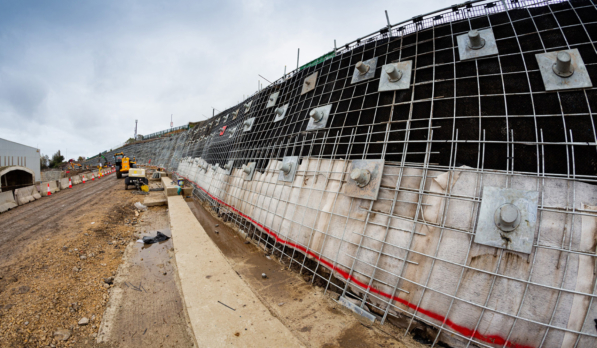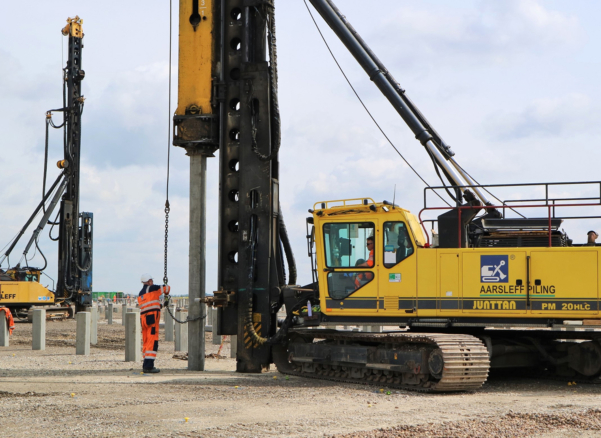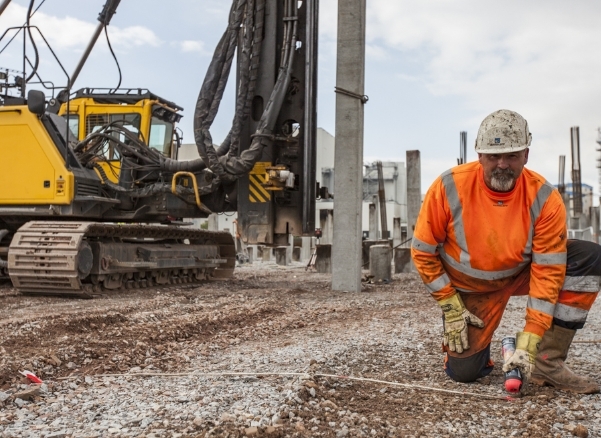What Are Bored Piles?
Table of Contents
- About Bored Piling
- What Is a Bored Pile Foundation?
- How Are Bored Piles Installed?
- Is Bored Piling Different from Screw Piling?
- Advantages of Rotary Bored Piling
- What Is the Difference Between Large and Small Diameter Bored Piles?
- What Are the Advantages of Bored Piles?
About Bored Piling
Bored piling, or rotary bored piling, is especially suited to boring through hard strata, as they are often larger in diameter than a continuous flight auger (CFA) piling method and can penetrate through difficult ground obstructions.
Rotary bored piles, also known as bored cast in situ concrete piles or drilled piles, are best used for tall structures, heavy vertical loads and brickwork. These piles are more compact than other conventional methods, allowing work to be delivered within confined sites. The term replacement pile is often used as opposed to displacement piles where soil is forced away by driving the pile in place. [1]

What Is a Bored Pile Foundation?
A bored pile foundation is a type of reinforced concrete foundation that supports structures with heavy vertical loads. Unlike driven precast piles, bored piles are cast-in-place using concrete on site.
How Are Bored Piles Installed?
The rotary piling technique is performed by drilling through a temporary casing to the designed depth, using an auger, eliminating any spoils. The casing supports the pile through to the ground until the required depth is achieved, the auger is then removed, and the concrete is poured in situ to form the bored pile.
This video demonstrates the installation of Kelly Bored Piles using a large bored piling rig:
The excavation of the auger bored piles is done using a large drill driven by a heavy drill motor. The stability of the borehole is upheld by placing steel casings, which are driven into the soil using a telescopic Kelly bar. When casting concrete around the pile, the steel casings are recovered.
Is Bored Piling Different from Screw Piling?
Both bored piling and screw piling are deep foundation solutions, but they have some differences. While bored piling involves drilling a borehole into the ground through a temporary casing and filling it with concrete, screw piling is performed by driving steel screws with helices on the outside into the soil. The screw piles are designed without having to remove any soil.
Advantages of Rotary Bored Piling
Rotary bored piling is one of the most widely used bored pile techniques, particularly suited for sites where large diameters or deep penetration into hard strata are required. It offers several distinct advantages, making it one of the most versatile piling methods for challenging ground conditions.
This method can be installed in the vast majority of soil types, including dense strata and rock, and is ideally suited where high structural load capacity is required. Using specialist drilling tools such as buckets, augers, and core barrels, rotary bored piling can penetrate man-made obstructions and create rock sockets for increased end-bearing capacity.
It also achieves tight tolerances near boundaries, making it suitable for restricted urban sites and basement works. In addition, rotary bored piles can incorporate advanced monitoring systems, such as fibre-optic instrumentation, allowing for real-time performance assessment and quality control throughout the construction process.
What Is the Difference Between Large and Small Diameter Bored Piles?
Bored piles are known as large diameter piles if they have a diameter of 600 mm or more. Small diameter bored piles are less than 600 mm and are sometimes placed in groups under a common pile cap to support heavy loads. [2]
The bearing capacity of large diameter piles can be increased by under-reaming the shaft at the base. This is achieved by an expanding cutting tool which cuts a conical-shaped base up to three times the diameter of the main shaft.
What Are the Advantages of Bored Piles?
The main advantages of bored piles include:
- Can be designed for high lateral loadings and vertical loadings.
- Can be installed in close proximity to existing structures and buildings.
- Various pile sizes can range from variable lengths, 600mm to 2000mm diameters and up to 50m deep which allows the pile to extend through soft, compressible, or swelling soils into the suitable bearing material.
- The need for large excavations and backfill is minimised.
- Less disruption to adjacent soil occurs.
- Vibration is relatively low, reducing disturbance to the surrounding environment.

Sources








